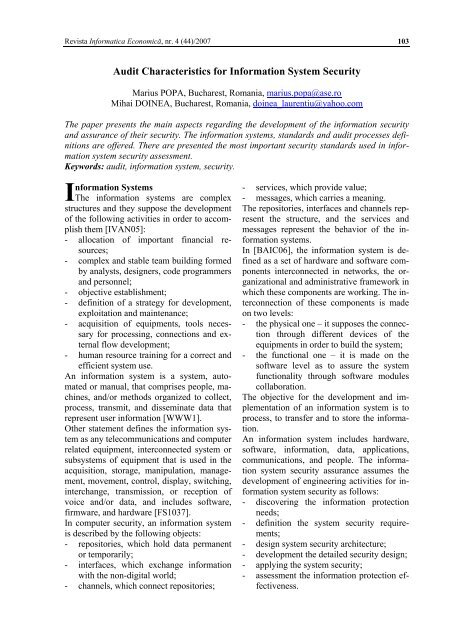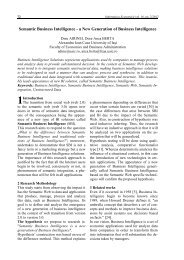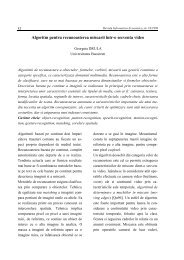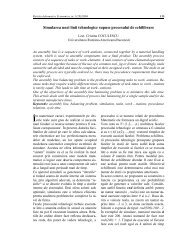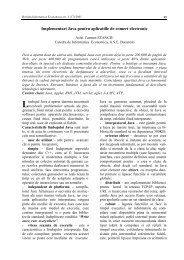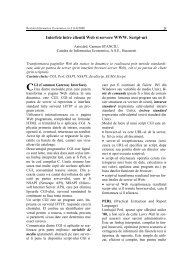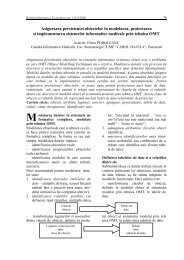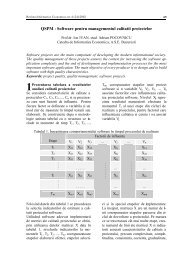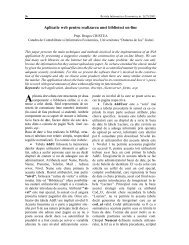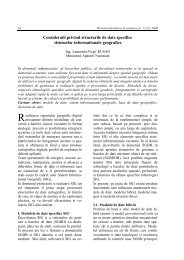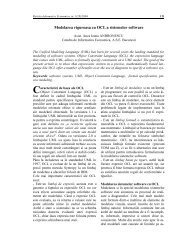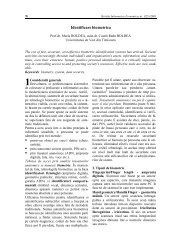Audit Characteristics for Information System Security
Audit Characteristics for Information System Security
Audit Characteristics for Information System Security
Create successful ePaper yourself
Turn your PDF publications into a flip-book with our unique Google optimized e-Paper software.
Revista In<strong>for</strong>matica Economică, nr. 4 (44)/2007 103<br />
<strong>Audit</strong> <strong>Characteristics</strong> <strong>for</strong> In<strong>for</strong>mation <strong>System</strong> <strong>Security</strong><br />
Marius POPA, Bucharest, Romania, marius.popa@ase.ro<br />
Mihai DOINEA, Bucharest, Romania, doinea_laurentiu@yahoo.com<br />
The paper presents the main aspects regarding the development of the in<strong>for</strong>mation security<br />
and assurance of their security. The in<strong>for</strong>mation systems, standards and audit processes definitions<br />
are offered. There are presented the most important security standards used in in<strong>for</strong>mation<br />
system security assessment.<br />
Keywords: audit, in<strong>for</strong>mation system, security.<br />
I<br />
n<strong>for</strong>mation <strong>System</strong>s<br />
The<br />
in<strong>for</strong>mation systems are complex<br />
structures<br />
and they suppose the development<br />
of the following activities in order to accomplish<br />
them [IVAN05]:<br />
- allocation of important financial resources;<br />
- complex and stable team building <strong>for</strong>med<br />
by analysts, designers, code programmers<br />
and personnel;<br />
- objective establishment;<br />
- definition of a strategy <strong>for</strong> development,<br />
exploitation and maintenance;<br />
- acquisition of equipments, tools necessary<br />
<strong>for</strong> processing, connections and external<br />
flow development;<br />
- human resource training <strong>for</strong> a correct and<br />
efficient system use.<br />
An in<strong>for</strong>mation system is a system, automated<br />
or manual, that comprises people, machines,<br />
and/or methods organized to collect,<br />
process, transmit, and disseminate data that<br />
represent user in<strong>for</strong>mation [WWW1].<br />
Other statement defines the in<strong>for</strong>mation system<br />
as any telecommunications and computer<br />
related equipment, interconnected system or<br />
subsystems of equipment that is used in the<br />
acquisition, storage, manipulation, management,<br />
movement, control, display, switching,<br />
interchange, transmission, or reception of<br />
voice and/or data, and includes software,<br />
firmware, and hardware [FS1037].<br />
In computer security, an in<strong>for</strong>mation system<br />
is described by the following objects:<br />
- repositories, which hold data permanent<br />
or temporarily;<br />
- interfaces, which exchange in<strong>for</strong>mation<br />
with the non-digital world;<br />
- channels, which connect repositories;<br />
- services, which provide value;<br />
- messages, which carries a meaning.<br />
The repositories, interfaces and channels represent<br />
the structure, and the services and<br />
messages represent the behavior of the in<strong>for</strong>mation<br />
systems.<br />
In [BAIC06], the in<strong>for</strong>mation system is defined<br />
as a set of hardware and software components<br />
interconnected in networks, the organizational<br />
and administrative framework in<br />
which these components are working. The interconnection<br />
of these components is made<br />
on two levels:<br />
- the physical one – it supposes the connection<br />
through different devices of the<br />
equipments in order to build the system;<br />
- the functional one – it is made on the<br />
software level as to assure the system<br />
functionality through software modules<br />
collaboration.<br />
The objective <strong>for</strong> the development and implementation<br />
of an in<strong>for</strong>mation system is to<br />
process, to transfer and to store the in<strong>for</strong>mation.<br />
An in<strong>for</strong>mation system includes hardware,<br />
software, in<strong>for</strong>mation, data, applications,<br />
communications, and people. The in<strong>for</strong>mation<br />
system security assurance assumes the<br />
development of engineering activities <strong>for</strong> in<strong>for</strong>mation<br />
system security as follows:<br />
- discovering the in<strong>for</strong>mation protection<br />
needs;<br />
- definition the system security requirements;<br />
- design system security architecture;<br />
- development the detailed security design;<br />
- applying the system security;<br />
- assessment the in<strong>for</strong>mation protection effectiveness.
104<br />
The aim of the in<strong>for</strong>mation system security<br />
compliance is to assure protection of the<br />
physical and logical components and of the<br />
data stored in system towards the threats that<br />
exploit the vulnerabilities of the system.<br />
2. <strong>Security</strong> Standards <strong>for</strong> In<strong>for</strong>mation <strong>System</strong>s<br />
The standards are developed by different organizations<br />
or groups of specialists <strong>for</strong> usage<br />
within the organization, by the specialists<br />
groups or organizations or by an entire industry.<br />
The objective <strong>for</strong> standard development<br />
is to assure the uni<strong>for</strong>mity character of the<br />
different aspects measuring within organization,<br />
thus making comparative evaluations.<br />
A standards organization is any entity whose<br />
primary activities are developing, coordinating,<br />
promulgating, revising, amending, reissuing,<br />
interpreting, or otherwise maintaining<br />
standards that address the interests of a wide<br />
base of users outside the standards development<br />
organization [WWW1].<br />
There are some organizations that unintentionally<br />
acquired a status as the standards setter<br />
when a standard developed by them <strong>for</strong><br />
internal use has become widely used and recognized<br />
as the de facto standard.<br />
The in<strong>for</strong>mation security has the origin in<br />
military in<strong>for</strong>mation protection.<br />
One of the most known security standards is<br />
Orange Book (Department of Defense<br />
Trusted Computer <strong>System</strong> Evaluation Criteria).<br />
That standard was replaced by the system<br />
FIPS – Federal In<strong>for</strong>mation Processing<br />
Strategy.<br />
The standard BS7799 has been used since<br />
1995 in Europe. It was adopted as international<br />
standard under the name ISO 17799. It<br />
contains common elements with the Orange<br />
Book, but being more flexible and adaptable<br />
to any organization. The standard has known<br />
successive improvements, the latest version<br />
being adopted in 2005. The ISO 17799:2005<br />
standard structure contains 11 security controls.<br />
They are depicted in table no. 1.<br />
As internal use, ISO 17799:2005 has the purpose<br />
of:<br />
- measuring mean;<br />
- control menu;<br />
- to do objective;<br />
Revista In<strong>for</strong>matica Economică, nr. 4 (44)/2007<br />
- internal standard.<br />
Table no. 1 <strong>Security</strong> controls in ISO<br />
17799:2005<br />
<strong>Security</strong> Control Number of<br />
<strong>Security</strong><br />
Category<br />
<strong>Security</strong> Policy 1<br />
Organizing In<strong>for</strong>mation Se- 2<br />
curity<br />
Asset Management 2<br />
Human Resources <strong>Security</strong> 3<br />
Physical and Environmental 2<br />
<strong>Security</strong><br />
Communications and Opera- 10<br />
tions Management<br />
Access Control 7<br />
In<strong>for</strong>mation <strong>System</strong>s Acqui- 6<br />
sition, Development and<br />
Maintenance<br />
In<strong>for</strong>mation <strong>Security</strong> Incident 2<br />
Management<br />
Business Continuity Man- 1<br />
agement<br />
Compliance 3<br />
From the point of view of the organization’s<br />
relationship with the business environment,<br />
the standard is:<br />
- a reference point;<br />
- a requirement <strong>for</strong> the partners;<br />
- a part of a auction or an offer;<br />
- a part of insurance document;<br />
- a part of the service offered by a<br />
provider;<br />
- external audit standard.<br />
There are other security and audit standards<br />
<strong>for</strong> the in<strong>for</strong>mation systems.<br />
ISACA - In<strong>for</strong>mation <strong>System</strong>s <strong>Audit</strong> and<br />
Control Association developed different audit<br />
specifications <strong>for</strong> in<strong>for</strong>mation systems.<br />
The ISACA document contains the following<br />
auditing standards of the in<strong>for</strong>mation systems<br />
[ISACA]:<br />
- S1 – <strong>Audit</strong> Charter;<br />
- S2 – Independence;<br />
- S3 – Professional Ethics and<br />
Standards;<br />
- S4 – Competence;<br />
- S5 – Planning;<br />
- S6 – Per<strong>for</strong>mance of <strong>Audit</strong> Work;<br />
- S7 – Reporting;
Revista In<strong>for</strong>matica Economică, nr. 4 (44)/2007 105<br />
- S8 – Follow-Up Activities;<br />
- S9 – Irregularities and Illegal<br />
Acts;<br />
- S10 – IT Governance;<br />
- S11 – Use of Risk Assessment in<br />
<strong>Audit</strong> Planning;<br />
- S12 – <strong>Audit</strong> Materiality;<br />
- S13 – Using the Work of Other<br />
Experts;<br />
- S14 – <strong>Audit</strong> Evidence.<br />
The specifications from the mentioned standards<br />
are recognized at the global level as<br />
source <strong>for</strong> the assurance of the in<strong>for</strong>mation<br />
system security and <strong>for</strong> the audit processes<br />
carrying on.<br />
3. In<strong>for</strong>mation <strong>System</strong> <strong>Audit</strong><br />
The auditing of the in<strong>for</strong>matics systems and<br />
economic in<strong>for</strong>mation are branches of the<br />
general audit.<br />
The literature includes the following concepts<br />
of the audit [CAPS06]:<br />
- <strong>Audit</strong> of In<strong>for</strong>mation <strong>System</strong>s – it aims<br />
the assessment of the in<strong>for</strong>mation systems,<br />
the practices and operations regarding<br />
these ones;<br />
- <strong>Audit</strong> of Computer In<strong>for</strong>mation <strong>System</strong>s –<br />
it has the same significance with in<strong>for</strong>mation<br />
system audit in an environment<br />
based on computer usage;<br />
- Computer <strong>Audit</strong>ing – it has many meanings:<br />
computer usage as instrument <strong>for</strong><br />
auditing, audit in an environment based<br />
on computer usage or special investigations<br />
connected to financial audit.<br />
The responsibility <strong>for</strong> prevention and detection<br />
of the inconsistency and frauds in an in<strong>for</strong>mation<br />
system depends on the management staff.<br />
The latter has to be sure that this responsibility<br />
will be achieved through appliance of an adequate<br />
internal control system.<br />
The internal control system represents the entire<br />
control system established by management<br />
staff in order to make the organization’s<br />
processes orderly and efficiently. Thus, it assures<br />
the con<strong>for</strong>mity of the management<br />
methods, the protection of the capital and the<br />
completeness and accuracy of the records.<br />
The technical auditor assures the management<br />
staff that the planned controls are being<br />
made. In his activity, the technical auditor<br />
needs the standards and the procedures used<br />
to evaluate the system. I<br />
Also, he is involved in solutions’ elaboration<br />
and system design from the early stages of<br />
the system development.<br />
The technical auditor has the following roles:<br />
- taking into account all the functional<br />
risks;<br />
- IT security audit;<br />
- system audit and software application development.<br />
The system security audit aims [IVAN05]:<br />
- the management responsibility;<br />
- the incompatible function segregation;<br />
- the access control;<br />
- the physical security control;<br />
- the disaster effect prevention control.<br />
The ISO 17799:2005 standard includes some<br />
specifications regarding the audit process <strong>for</strong><br />
in<strong>for</strong>mation system security assurance. Thus,<br />
the following guidelines should be observed<br />
[ISO17799]:<br />
- audit requirements should be agreed with<br />
appropriate management;<br />
- the scope of the checks should be agreed<br />
and controlled;<br />
- the checks should be limited to read-only<br />
access to software and data;<br />
- access other than read-only should only<br />
be allowed <strong>for</strong> isolated copies of system<br />
files, which should be erased or given<br />
appropriate protection;<br />
- resources <strong>for</strong> per<strong>for</strong>ming the checks should<br />
be explicitly identified and made available;<br />
- requirements <strong>for</strong> special or additional<br />
processing should be identified and<br />
agreed;<br />
- all access should be monitored and<br />
logged to produce a reference trail;<br />
- the use of time stamped reference;<br />
- all procedures, requirements, and responsibilities<br />
should be documented;<br />
- the person(s) carrying out the audit<br />
should be independent.<br />
It is necessary to protect the access to in<strong>for</strong>mation<br />
systems audit tools and to prevent the<br />
misusing or compromising of them. If the<br />
audit of the in<strong>for</strong>mation system security is<br />
made by third party, it is necessary to take
106<br />
into account the risks regarding the use of the<br />
audit tools by this third party.<br />
4. Conclusions<br />
The development of the audit processes in<br />
order to assess the security level of the in<strong>for</strong>mation<br />
systems that are working in an organization<br />
is a very important aspect that<br />
must be taken into account.<br />
The organizations are safe from the in<strong>for</strong>mational<br />
point of view they implement in<strong>for</strong>mation<br />
systems in accordance with the security<br />
standards recognized as the best.<br />
The audit processes establish the difference<br />
between the standard specifications and the<br />
reality from the organization. Also, some<br />
proposals regarding the in<strong>for</strong>mation security<br />
improvement are made on the base of the audit<br />
process conclusions to the management<br />
staff of the organization.<br />
References<br />
[BAIC06], Floarea BAICU, Andrei Mihai<br />
BAICU – <strong>Audit</strong>ul şi securitatea sistemelor<br />
in<strong>for</strong>matice, Victor Printing House, Bucharest,<br />
2006<br />
[CANO06], Sergiu CAPISIZU, Gheorghe<br />
NOŞCA, Marius POPA – In<strong>for</strong>matics <strong>Audit</strong>,<br />
The symposium with international participation<br />
„The 37th International Scientific Symposium<br />
of METRA”, Bucharest, May 25-26,<br />
2006, „The 37th International Scientific<br />
Symposium of METRA”, Bucharest, 2006<br />
[CAPI06], Sergiu CAPISIZU, Gheorghe<br />
NOŞCA, Marius POPA – The In<strong>for</strong>matics<br />
<strong>Audit</strong> – Basic Concepts, International Workshop<br />
„In<strong>for</strong>mation <strong>System</strong>s & Operations<br />
Management”, Romanian-American University,<br />
Bucharest, March 1-2, 2006, „In<strong>for</strong>mation<br />
<strong>System</strong>s & Operations Management”,<br />
2006, Universul Juridic Publishing House<br />
Bucharest, pp. 350 – 357<br />
Revista In<strong>for</strong>matica Economică, nr. 4 (44)/2007<br />
[CAPS06], Sergiu CAPISIZU – Modele şi<br />
tehnici de realizare a auditului in<strong>for</strong>maţiei<br />
economice, ASE Bucharest, 2006, PhD<br />
Thesis<br />
[FS1037], Federal Standard 1037C<br />
[ISACA], In<strong>for</strong>mation <strong>System</strong>s <strong>Audit</strong> and<br />
Control Association – IS Standards, Guidelines<br />
and Procedures <strong>for</strong> <strong>Audit</strong>ing and Control<br />
Professionals, 7th of September, 2006<br />
[ISO17799], ISO 17799:2005 Standard<br />
[IVAN05], Ion IVAN, Gheorghe NOŞCA,<br />
Sergiu CAPISIZU – <strong>Audit</strong>ul sistemelor in<strong>for</strong>matice,<br />
ASE Printing House, Bucharest,<br />
2005<br />
[WWW1],<br />
www.wikipedia.org


